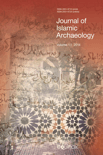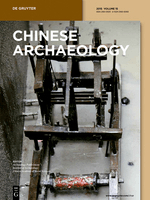
Kratkie Soobshcheniya Instituta Arkheologii
Scope & Guideline
Elevating Academic Standards in Archaeology and History
Introduction
Aims and Scopes
- Archaeological Excavations and Surveys:
This journal publishes results from field excavations and surveys, documenting findings from various archaeological sites, which contribute to the understanding of historical settlement patterns. - Material Culture Analysis:
A core focus is on the analysis of artifacts, including ceramics, metalwork, and organic materials, which helps in reconstructing past lifestyles and cultural practices. - Interdisciplinary Approaches:
The journal emphasizes interdisciplinary research by incorporating methodologies from fields such as anthropology, history, and environmental science to enrich archaeological interpretations. - Chronological Studies:
Research often includes chronological assessments using techniques like radiocarbon dating and dendrochronology to establish timelines and understand temporal changes in cultures. - Cultural and Historical Contextualization:
Papers frequently explore the cultural significance of findings within their historical context, addressing issues of trade, migration, and cultural exchange.
Trending and Emerging
- Technological Innovations in Archaeology:
There is an increasing emphasis on incorporating technological advancements, such as remote sensing and 3D modeling, to enhance archaeological investigations and documentation. - Environmental Archaeology:
Research that examines the relationship between past populations and their environments is gaining traction, emphasizing the importance of paleoecological studies. - Bioarchaeology and Anthropological Studies:
Emerging themes include bioarchaeological research that focuses on human remains, providing insights into health, diet, and social structures of ancient populations. - Cultural Interaction and Exchange:
An increasing number of papers explore themes of cultural interaction, trade networks, and migration patterns, reflecting a broader understanding of ancient societies as interconnected. - Interdisciplinary Collaborations:
There is a growing trend towards interdisciplinary collaborations, particularly between archaeology, genetics, and environmental sciences, which enriches the interpretative frameworks of archaeological findings.
Declining or Waning
- Traditional Pottery Studies:
Research centered on traditional pottery has diminished, possibly due to a shift towards more technologically advanced methods and a focus on broader cultural narratives. - Historical Archaeology of Recent Centuries:
There has been a noticeable decrease in studies related to historical archaeology from the recent centuries, as the journal's focus has shifted more towards prehistoric and early medieval contexts. - Site-Specific Local Studies:
Papers focusing exclusively on localized, site-specific studies are less frequent, as there is a growing trend towards integrating broader regional analyses. - Static Artifact Typologies:
The journal has moved away from static typological studies of artifacts, favoring more dynamic analyses that incorporate technological and functional aspects.
Similar Journals

Journal of Islamic Archaeology
Advancing Knowledge in Islamic ArchaeologyJournal of Islamic Archaeology is a distinguished publication dedicated to advancing the field of archaeology through the lens of Islamic heritage and culture. Published by EQUINOX PUBLISHING LTD, this journal provides a platform for researchers, professionals, and students to disseminate their findings and engage in critical dialogue regarding the archaeological aspects of Islamic societies from 2014 to the present. With an ISSN of 2051-9710 and E-ISSN 2051-9729, the journal is indexed within significant academic databases and positioned notably in the Q3 and Q2 quartiles for archaeology in the Arts and Humanities and Social Sciences categories, respectively. The journal fosters scholarly exchange and innovation, drawing attention to the rich tapestry of Islamic archaeology, and securing its role as an essential resource for practitioners and academics alike. Its commitment to rigorous peer-review and high-quality contributions ensures a valuable repository of knowledge, enhancing the understanding of an often underrepresented field in archaeology.

Archeologicke Rozhledy
Connecting disciplines, enriching archaeology.Archeologicke Rozhledy, published by the Academy of Sciences of the Czech Republic, Institute of Archaeology, is a pivotal open-access journal dedicated to advancing the field of archaeology. Since transitioning to open access in 2019, it has made significant strides in disseminating high-quality research, serving as a vital resource for researchers, professionals, and students alike. With an ISSN of 0323-1267, the journal has gained recognition for its contributions in the domains of arts and humanities, particularly archaeology, as evidenced by its 2023 Q2 ranking in both categories. Operating out of the historical city of Prague, the journal encompasses a broad scope of archaeological scholarship, reflecting a commitment to interdisciplinary approaches and fostering dialogue within the global archaeological community. With its notable Scopus rankings—#115/413 in Arts and Humanities and #113/354 in Social Sciences—Archeologicke Rozhledy stands as a crucial outlet for innovative research and scholarly exchange.

Ancient Asia-Journal of the Society of South Asian Archaeology
Fostering Interdisciplinary Insights into South Asian ArchaeologyAncient Asia - Journal of the Society of South Asian Archaeology, published by ARF India, stands as a pivotal resource for the exploration and dissemination of archaeological research focused on the rich history and culture of South Asia. Since its inception as an Open Access journal in 2006, it has become an essential platform for scholars and enthusiasts alike, boasting an impressive range of quartile rankings across multiple disciplines, including Anthropology, Archaeology, History, and Visual Arts. With expansion into various indexed categories and consistent dissemination of impactful research common to this highly diverse field, Ancient Asia aims to foster interdisciplinary dialogue, facilitate collaboration among researchers, and enhance the global understanding of ancient civilizations within the region. By embracing an inclusive access model, the journal encourages wide readership and engagement, positioning itself as a key player for students, professionals, and academics interested in delving into the archaeological marvels of South Asia.

Yorkshire Archaeological Journal
Advancing Knowledge in Yorkshire's Archaeological LandscapeYorkshire Archaeological Journal, published by Routledge Journals, Taylor & Francis Ltd, stands as a pivotal resource in the field of archaeology, particularly focused on the rich heritage and archaeological research within the Yorkshire region of the United Kingdom. With a dedicated ISSN of 0084-4276 and an E-ISSN of 2045-0664, this journal provides both researchers and practitioners valuable insights into archaeological discoveries, methodologies, and theoretical frameworks. While it holds a Q3 ranking in both Archaeology (Arts and Humanities) and Archaeology (Social Sciences), its contributions remain significant for advancing discussions and knowledge within the discipline. The journal's archival depth, converging from as early as 1980 and continuing robustly into 2024, showcases a commitment to fostering academic discourse and exploration of archaeological heritage. Although it does not currently offer open access, its rigorous peer-reviewed articles make it an essential reference for academics, professionals, and students alike who are eager to deepen their understanding of archaeology and its applications.

Journal of Pacific Archaeology
Bridging Cultures Through Archaeological DiscoveryThe Journal of Pacific Archaeology, published by the New Zealand Archaeological Association, serves as a pivotal platform for disseminating cutting-edge research in the field of archaeology across the Pacific region. With an ISSN of 1179-4704 and an E-ISSN of 1179-4712, the journal provides a forum for scholarly discourse aimed at both established researchers and emerging scholars alike. Focusing on the rich tapestry of archaeological studies, it covers a diverse array of topics, from ancient settlement patterns and cultural practices to contemporary analyses of material culture. As an Open Access journal, it ensures that its findings are readily available to all, fostering inclusivity in academic research and enabling practitioners to share knowledge without barriers. The Journal of Pacific Archaeology is indispensable for those committed to understanding the complexities and nuances of Pacific archaeology, making significant contributions to both regional and global archaeological narratives.

Origini
Bridging the Gap Between Past and Present Knowledge.Origini is a distinguished journal dedicated to the field of archaeology, published by EDIZIONI QUASAR S TOGNON SRL in Italy. With an ISSN of 0474-6805, it offers a platform for researchers and professionals to share their latest findings and insights. Having achieved a significant Q2 ranking in both Archaeology (Arts and Humanities) and Archaeology (Social Sciences) categories according to Scopus, it positions itself as a respected source of scholarly communication in the discipline. Over the converged years from 2017 to 2023, Origini has consistently aimed to advance archaeological research, fostering an environment where innovative theories and methodologies can be developed and discussed. Although it is not an Open Access journal, its contributions remain vital for academics and students seeking to deepen their understanding of archaeological practices and historical narratives. With a commitment to excellence, Origini stands as an essential resource within the archaeological community, inviting contributions that push the boundaries of knowledge and interpretation.

Fornvannen-Journal of Swedish Antiquarian Research
Bridging the Past and Present of Swedish HistoryFornvannen - Journal of Swedish Antiquarian Research is a distinguished peer-reviewed journal dedicated to advancing the field of antiquarian studies through rigorous research and scholarship. Published by the Royal Academy Letters, History & Antiquities in Sweden, this journal has been a cornerstone of archaeological and historical discourse since its inception in 1978. It currently holds an esteemed position in the Q3 category in both Archaeology and History as per the 2023 assessments, reflecting its commitment to promoting high-quality academic contributions. With an ISSN of 0015-7813 and an E-ISSN of 1404-9430, Fornvannen provides insights into Swedish antiquities and serves as a vital resource for researchers and scholars eager to explore the nuances of archaeological and historical findings. Although not an open-access journal, it offers a comprehensive platform for the dissemination of knowledge within the fields of arts and humanities. As it continues its journey from 2011 to 2024, Fornvannen remains pivotal in fostering scholarly dialogue and enhancing our understanding of Sweden’s rich historical tapestry.

Chinese Archaeology
Connecting Scholars to China's Archaeological WondersChinese Archaeology, published by WALTER DE GRUYTER GMBH, is a leading journal dedicated to the exploration and study of China's rich archaeological heritage. With an ISSN of 2160-5025 and an E-ISSN of 2160-5068, this journal serves as an essential platform for scholars, researchers, and enthusiasts in the field of archaeology, offering a blend of original research articles, reviews, and critical essays that address both contemporary issues and historical narratives. While it currently operates under a conventional access model, making cutting-edge research available to a select audience, it plays a crucial role in advancing knowledge about China's archaeological sites, artifacts, and past civilizations. Given the increasing interest in Eastern archaeology and its significance in a global context, Chinese Archaeology is positioned as a pivotal resource for understanding and interpreting the complexities of China’s historical evolution. Researchers and academics are encouraged to contribute and engage with this vital field of study to foster greater insights and innovations.

Vjesnik Arheoloskog Muzeja u Zagrebu
Exploring the Depths of Croatia's Archaeological RichesVjesnik Arheoloskog Muzeja u Zagrebu, published by the ARHEOLOSKI MUZEJ & ZAGREBU, is a vital platform for disseminating scholarly research in the field of archaeology. With its Open Access model established in 2007, the journal ensures that vital archaeological findings and theories are accessible to a global audience, fostering greater collaboration and knowledge-sharing among researchers, professionals, and students. The journal is based in Croatia and has been an essential part of the academic landscape since its inception, with convergence noted in years such as 1979 and 1981, and continuing consistently from 2014 to 2023. While it currently holds a Q4 ranking in both the Arts and Humanities and Archaeology categories, its contributions to the understanding of archaeological heritage in the region are invaluable. Positioned within the 30th percentile among its peers in Scopus rankings, the journal endeavors to elevate the discourse around archaeological practices and findings, making it an important resource for anyone engaged in the pursuit of archaeological knowledge.

Baltica
Illuminating the Path of Geological Discovery.Baltica is a distinguished journal housed under the Institute of Geology and Geography in Lithuania, focusing on the diverse realms of Earth and Planetary Sciences. Established in the mid-1990s, with a publication history dating back to 1994, the journal has continually sought to advance scholarly communication and innovation within the field. Although presently categorized in the Q4 quartile of Earth and Planetary Sciences, its contributions remain vital for researchers, professionals, and students interested in interdisciplinary approaches to understanding our planet’s dynamics. With an ISSN of 0067-3064 and an E-ISSN of 1648-858X, Baltica disseminates valuable findings and discussions that appeal to a broad academic audience, encouraging critical thinking and knowledge exchange. While the journal lacks Open Access options, it nonetheless serves as a significant platform for emerging and established scholars alike, facilitating a deeper engagement with critical geographical and geological research.